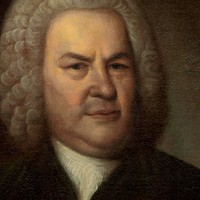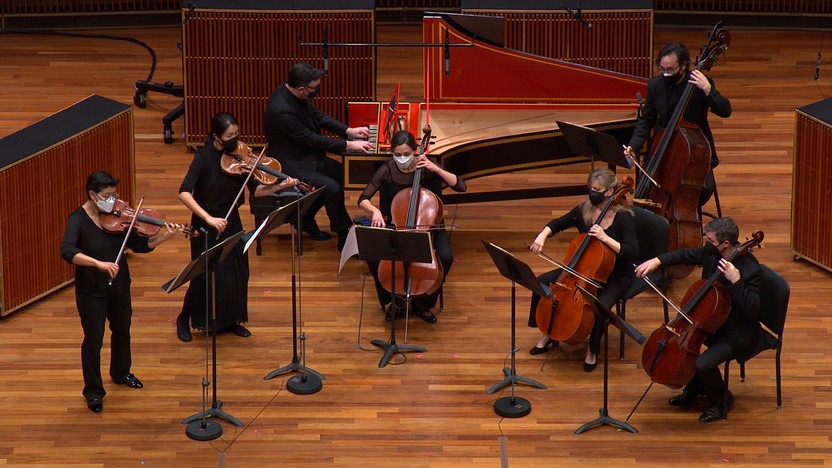Details
 Watch Video
Watch Video
Johann Sebastian Bach
Brandenburg Concerto No. 5 (21 min)
Johann Sebastian Bach’s Fifth Brandenburg Concerto features flute, violin and harpsichord as soloists. Such a trio was a common chamber music ensemble at the time, playing works known as trio sonatas. What is remarkable about this concerto is that the harpsichord functions as more than a supporting accompanist; it contributes whirlwind solo lines, and it issues a monster of a cadenza at the end of the first movement. This use of the harpsichord as a solo instrument foreshadows the seminal keyboard concertos Bach later assembled in Leipzig.
The middle movement, labeled Affettuoso (“with feeling”), presents the soloists without the accompanying strings. Unlike a trio sonata, in which the harpsichord would typically have just a bass line with the right-hand harmonies filled in ad libitum, the harpsichordist’s right hand plays its own melodic line that intermingles with the flute and violin. In the finale, a fugue reinforces the equal footing of the voices. The violin and flute take the first two entrances, and the harpsichord jumps in with the third and fourth voices of the fugue.
Aaron Grad ©2021
 Watch Video
Watch Video
Johann Sebastian Bach
Brandenburg Concerto No. 6 (19 min)
Johann Sebastian Bach’s Sixth Brandenburg Concerto limits its palette to the lower strings, including instruments from the viol family that have fallen out of fashion. With the violins absent, the two top lines go to instruments labeled viola da braccio, or viola “on the arm” — meaning violas in the modern sense, held like violins. Joining as a third solo voice is a cello, also from the violin family.
The accompanying lines, marked viola da gamba and violone, indicate bowed instruments that have frets tied to the fingerboard, and that are held upright (“da gamba” means “on the leg”). The inclusion of relatively simple viola da gamba parts may have been an attempt on Bach’s part to include his employer, Prince Leopold, who played the instrument reasonably well. In modern practice, two cellos and a contrabass substitute for the viols.
A distinguishing aspect of the first movement is its very slow harmonic motion in the tutti sections, with persistent pulses holding steady while the violas add decorative filigree. If this was one way to avoid straining a less confident viol player such as the prince, the middle movement solves the problem by eliminating the viols entirely. The violas spin out long lines that rise into the violin’s usual register, supported by walking cello lines and spacious accompaniment from the basso continuo. The finale is another festive dance in the style of a gigue, in which the soloists elaborate the main theme with passages of flowing sixteenth-notes.
Aaron Grad ©2021
 Watch Video
Watch Video
Johann Sebastian Bach
Brandenburg Concerto No. 4 (17 min)
(Duration: 17 min)
Johann Sebastian Bach’s Fourth Brandenburg Concerto showcases a violin along with two parts identified as “echo flutes,” a mysterious term that appears nowhere else in Bach’s music. Scholars agree (for the most part) that the intended instruments were treble recorders, and that the “echo” label referred to the loud and soft alternations in the middle movement, creating an echo-like sound. In performances on modern instruments, flutes typically substitute for the recorders.
In the fast first movement, the violin takes the flashiest material, including long strings of arpeggios, a series of double-stops (the technique of playing two notes at once) and a wickedly fast passage of slurred 32nd-notes. The characteristic tone of the flutes becomes more prominent in the middle movement, with the violin dropping into the role of the bass instrument to support the higher voices. The movement ends on an unresolved chord that should proceed to E minor, the slow movement’s home key, but instead the violas launch the Presto finale in G major, where the concerto started. Their robust entrance marks the start of a virtuosic fugue.
Aaron Grad ©2021
About This Program
The SPCO presents Johann Sebastian Bach’s most cherished set of orchestral works, the Brandenburg Concertos. The profound inventiveness and instrumental virtuosity of the enduring baroque masterpieces are on full display as led by our own SPCO musicians and soloists.
All audience members are required to present proof of full COVID-19 vaccination or a negative COVID-19 test within 72 hours prior to attending this event. Masks are required regardless of vaccination status. More Information
Concerts are currently limited to 50% capacity to allow for distancing. Tickets are available by price scale, and specific seats will be assigned and delivered a couple of weeks prior to each concert — including Print At Home tickets. Please email us at tickets@spcomail.org if you have any seating preferences or accessibility needs. Seating and price scale charts for the Ordway Concert Hall can be found at thespco.org/venues.
Contribute
SPCO concerts are made possible by audience contributions.
Newsletter
For exclusive discounts, behind-the-scenes info, and more:
Sign up for our email club!

